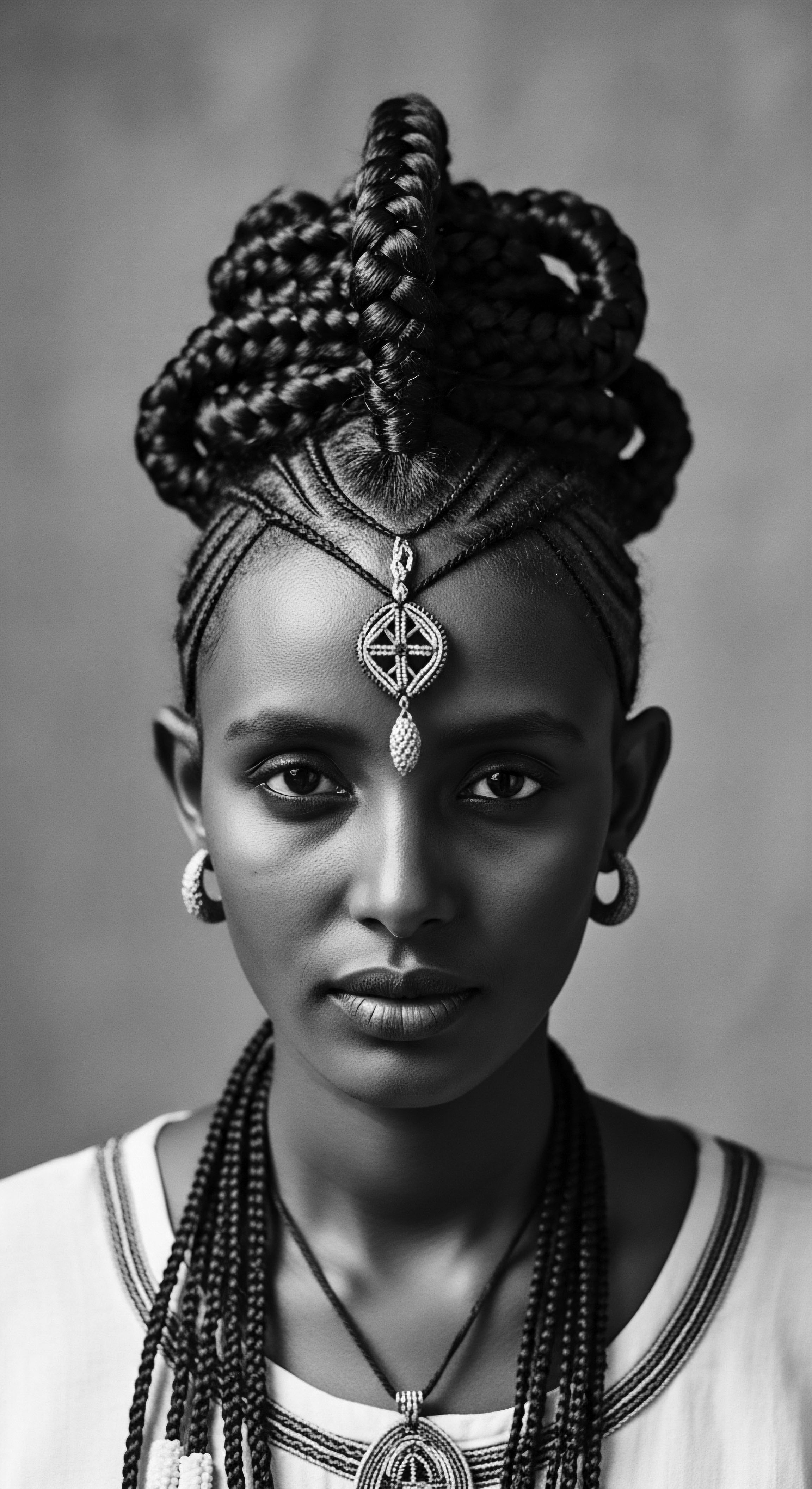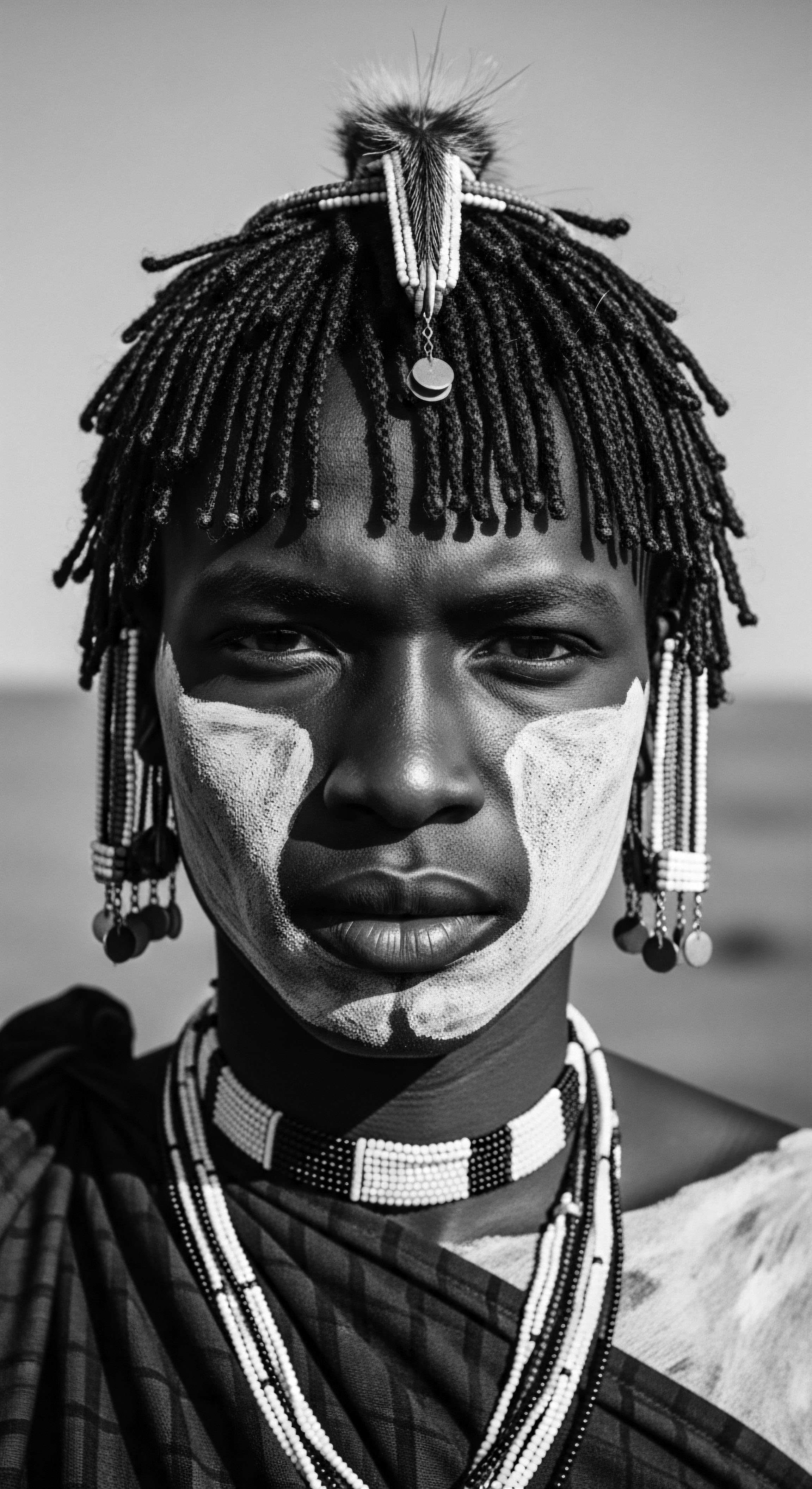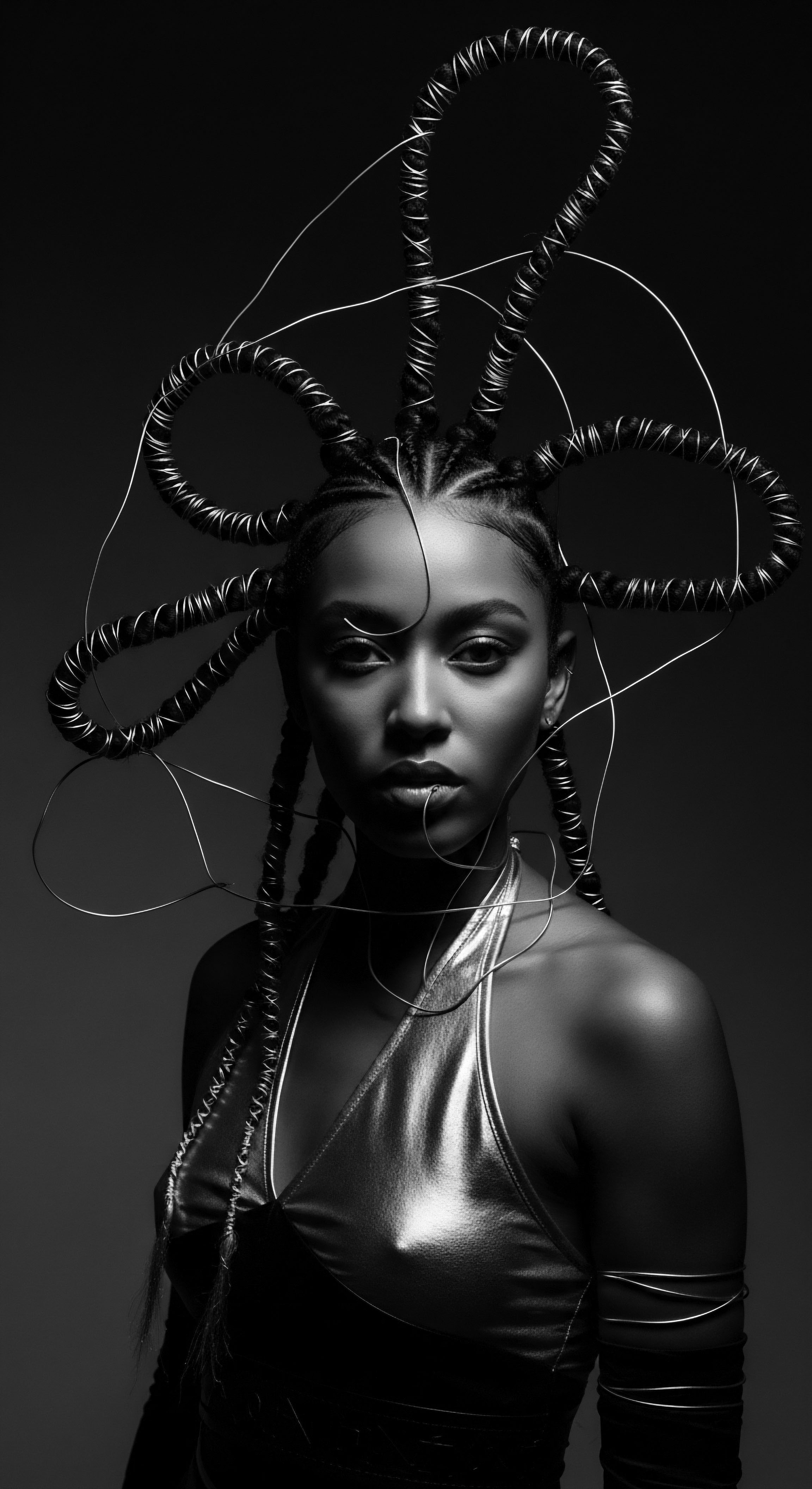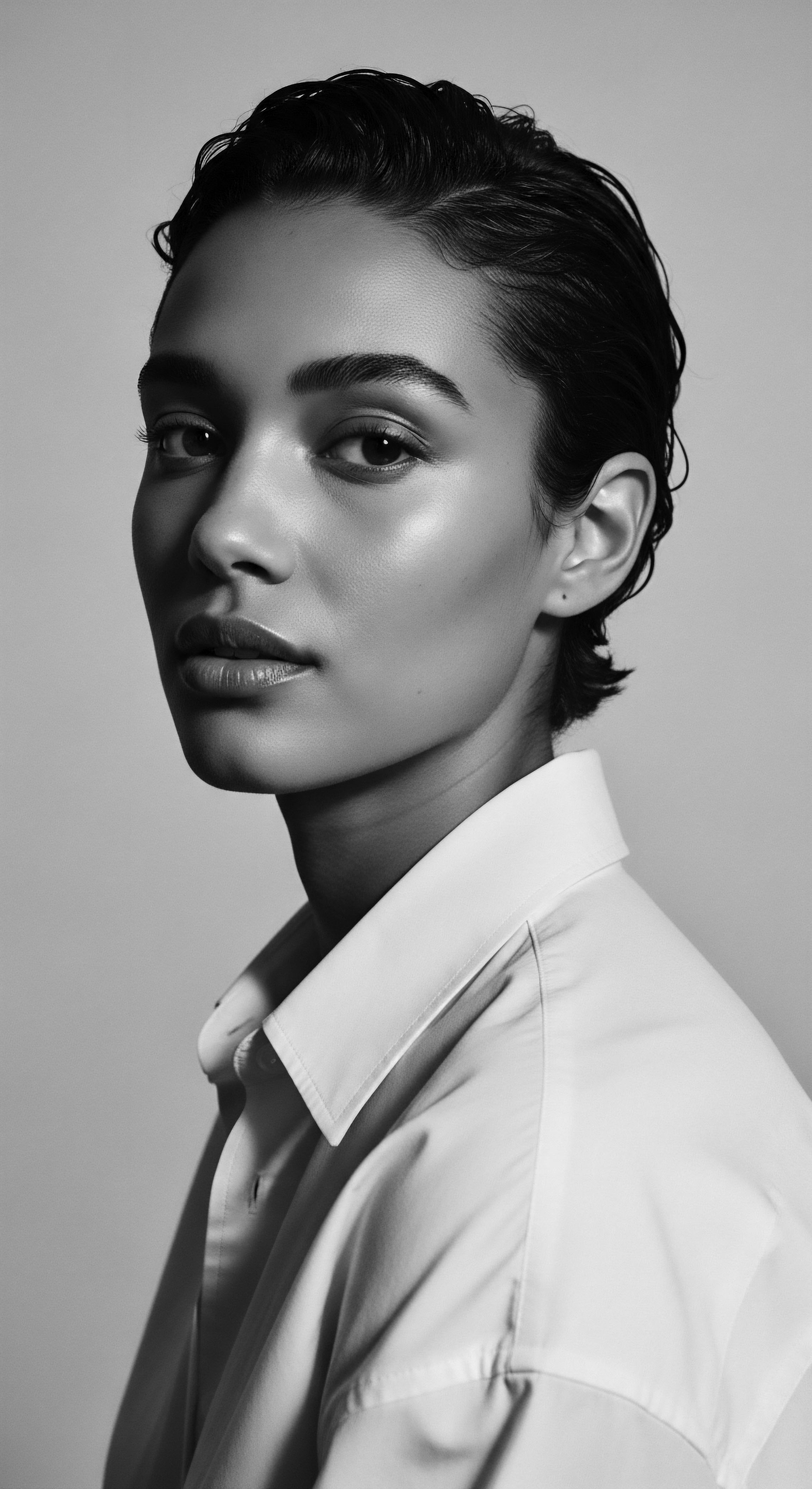
Fundamentals
The study of Pre-Columbian Adornment invites us to step into the vibrant, living archives of ancient Americas, where expressions of self and community were etched, woven, and styled onto the very body. At its simplest, Pre-Columbian Adornment describes the myriad ways indigenous peoples across Mesoamerica, the Andes, and other regions of the Americas embellished themselves prior to the arrival of Christopher Columbus in 1492. This encompasses a vast array of practices, including tattooing, body painting, intricate garment design, and the wearing of jewelry fashioned from materials like gold, silver, jade, shells, and feathers. More than mere decoration, each adornment carried profound cultural, spiritual, and social weight.
Its purpose extended beyond aesthetics, often communicating a person’s identity, social standing, tribal affiliation, spiritual beliefs, or readiness for life events. This initial look uncovers the fundamental understanding of these expressions.
For those exploring this rich historical landscape, the direct explanation of Pre-Columbian Adornment begins with recognizing its holistic nature. These societies did not separate beauty from daily life, from ceremonial practice, or from the natural world surrounding them. The materials chosen for adornment often held specific symbolic meaning rooted in their origin or the cosmology of the people.
For instance, the shimmering green of jade in Mesoamerica linked its wearer to maize, water, and fertility, while the vibrant hues of macaw feathers in Andean cultures could signify connections to the sun and sky. The very act of crafting these adornments, whether spinning precious fibers or shaping metals, was a ritual in itself, imbuing the object with power and resonance before it ever touched the skin or hair.
Hair, in particular, served as a potent canvas for these expressions, holding unique significance that speaks directly to our textured hair heritage. Hair was not just fiber; it was often viewed as an extension of one’s life force, a direct link to ancestors, and a channel for spiritual communication. The delineation of Pre-Columbian Adornment must therefore acknowledge the central role of hair practices.
Early ceramic figurines from cultures such as the Valdivian (Ecuador) illustrate elaborately styled hair, often formed separately and added to the figures, indicating the importance placed on coiffure even in sculptural representation. Such artistry offers glimpses into a world where hair was meticulously styled, braided, and accented with precious objects, not as a passing trend, but as a deep manifestation of belonging and belief.
Ancestral practices concerning hair care were also deeply intertwined with adornment. Communities understood the intrinsic properties of their hair and adapted natural resources for its health and styling. The very concept of care as a sacred ritual was woven into these daily and ceremonial acts. Before the advent of synthetic products, indigenous peoples across the Americas cultivated a profound connection with their local flora for cleansing and conditioning.
For example, some Native American tribes in North America utilized extracts from plants like the coastal woodfern ( Dryopteris expansa ) as hair cleansers. In the Andean civilizations, a soapy by-product of quinoa, the saponin, was used as a shampoo, highlighting an inventive and sustainable approach to hair hygiene. These methods were not random acts; they were ancestral knowledge passed down through generations, ensuring hair was healthy enough to hold the intricate styles and heavy adornments that marked identity.
Understanding Pre-Columbian Adornment on a fundamental level requires appreciating the sacred relationship between body, spirit, and community. It was a language spoken through visual art, a statement of identity, and a profound connection to the cosmic order.
Pre-Columbian Adornment, at its core, represents the intricate visual language ancient American peoples used to express identity, social standing, and spiritual beliefs, with hair serving as a particularly sacred canvas.
The materials employed for adornment were selected not only for their beauty but also for their perceived energetic properties and connotation within their cosmological frameworks. Gold, a material often reserved for royalty and deities, was understood to embody the sun’s radiance, linking the wearer to divine power. Silver, associated with the moon, carried its own reflective sense. Feathers from specific birds, such as the resplendent quetzal, were not merely beautiful; they were believed to carry the spirit and characteristics of the creature itself, offering a symbolic designation of connection to the animal kingdom or the heavens.
The styles, too, held a purport beyond the visible. Braids, often seen on ancient mummies like “Juanita” of Peru, represented longevity and continuity, sometimes conveying messages about tribal affiliation or social roles. The meticulousness involved in creating these styles, often taking hours or days, reinforces their deep import for the communities. These practices were not fleeting fashion trends; they were integral components of cultural survival and self-representation, acts of affirming one’s place within a collective memory and spiritual cosmos.
The initial description of Pre-Columbian Adornment offers a starting point, yet its true depth lies in recognizing how these ancient gestures continue to whisper across time, reminding us of the enduring human desire to connect with heritage and express identity through physical manifestation.

Intermediate
Moving beyond a foundational elucidation, the intermediate understanding of Pre-Columbian Adornment expands into its complex societal roles and diverse expressions across various cultural landscapes. It was a sophisticated system of visual communication, often dictating social interactions and reinforcing hierarchical structures within communities. The interpretation of these adornments requires familiarity with the unique worldview of each Pre-Columbian civilization, recognizing that similar forms might carry vastly different significance depending on the cultural context.
Consider the variations in hair adornment as a prime example. In Mesoamerican societies, hairstyles often conveyed intricate details about a person’s status, profession, or marital standing. Aztec codices, ancient pictorial manuscripts, illustrate an impressive array of hairstyles, each carefully regulated to signify a specific role within the empire.
Warriors, for instance, distinguished their rank through elaborate styles or unique hair ornaments, while priests often wore their hair long and untended, even matted, to signify their spiritual dedication. This adherence to specific hair expressions highlights how integral physical appearance was to social order and individual identification .
Beyond mere beauty, Pre-Columbian Adornment served as a complex visual language, communicating social standing, spiritual ties, and communal roles through meticulous craft and symbolic materials.
The materials utilized for adornment were not simply chosen for their aesthetic appeal; they were imbued with profound meaning drawn from nature and cosmology. Feathers, for instance, from the vivid quetzal bird (a creature revered by the Maya and Aztecs), were reserved for elite headdresses, symbolizing connections to the divine and the sky. Gold and jade, precious and difficult to acquire, were often crafted into ear spools, pendants, and beads, adorning those of high social or spiritual standing, designating their proximity to power and sacred entities. The very acquisition of these materials involved complex trade networks, further cementing their value and the importance of their display.
Moreover, the intermediate lens reveals how hair care was not merely about cleanliness but about ritual and connection to ancestral wisdom. The practices of washing, oiling, and styling hair were deeply rooted in ancestral knowledge, often drawing from specific plant properties. The Andean civilizations, for instance, utilized saponins from quinoa as a shampoo, a practice deeply connected to their agricultural and spiritual life. Such specifications underscore a holistic approach to well-being where hair maintenance was a sacred act.
The spiritual dimension of hair in these cultures holds particular resonance for textured hair heritage. For the Mexica-Aztecs, hair was considered a powerful receptacle of tonalli, a life force or spiritual essence. A person’s tonalli was believed to reside partially in their hair, making hair cutting a severe punishment that exposed one to a loss of spiritual power.
The family would preserve the first hair cut from a child and the last hair after death, placing it with the deceased’s ashes, viewing it as a memory and a continued presence of the life force. This belief system extends a profound invitation to consider how textured hair, with its unique patterns and strength, could have been perceived as a particularly potent conduit for spiritual energy, linking the individual tangibly to the cosmic and ancestral realms.
The enduring legacy of hair practices, particularly braiding, offers a compelling bridge to understanding the connotation of Pre-Columbian Adornment within Black and mixed-race hair experiences. Across various Pre-Columbian societies, braids were a widespread and significant form of hair artistry. Ancient mummies in Peru, such as Mummy Juanita, show evidence of intricate braiding patterns.
The Maya and Aztec civilizations also utilized diverse braiding techniques to indicate tribal affiliation and social standing. This common thread of braiding as a cultural marker within the Americas, long before European arrival, clarifies the rich, independent development of complex hair styling traditions.
The clarification here involves recognizing that these pre-existing hair cultures in the Americas later encountered, and in many cases, integrated with, African hair traditions brought by enslaved peoples. The transatlantic slave trade resulted in a blending of diverse hair textures and cultural practices in the Americas. African hair-braiding traditions, which themselves carried deep meaning as symbols of identity, resistance, and communication, merged with indigenous practices.
This fusion, particularly in regions with significant Afro-descendant populations, created unique hair expressions, demonstrating an adaptive resilience of heritage. It shows how ancient adornment practices, through the tender thread of communal knowledge, continued to inform and influence hair care and styling across centuries, reflecting a continuous conversation between past and present.

Academic
The scholarly definition of Pre-Columbian Adornment transcends a simple cataloging of objects; it represents a deeply embedded cultural syntax, an elaborate system of visual communication, and a profound manifestation of cosmic, social, and individual identity among the indigenous peoples of the Americas prior to 1492. This delineation considers adornment not as a static category but as an active process of self-creation and communal cohesion, inextricably linked to ecological knowledge, technological ingenuity, and intricate symbolic systems. Its meaning is multi-layered, encompassing notions of personhood, sacred connection, political authority, and the demarcation of temporal and spatial relationships.
A rigorous explanation demands an interdisciplinary lens, drawing from archaeology, anthropology, ethnohistory, and material culture studies. The artifacts themselves—from monumental sculptures depicting elaborate coiffures to minute beads found in ceremonial caches—serve as textual fragments of a silent language. This clarification recognizes that adornment was not a superficial layer; it was an integral part of the body, a second skin articulating complex cultural narratives.
The very materials used, whether shell, jade, gold, or feather, possessed intrinsic significance derived from their natural origins and the specialized labor involved in their transformation. For example, the precise sourcing of cinnabar for pigment or the intricate technique required to work gold alloys spoke volumes about a community’s trade networks, spiritual beliefs, and technical prowess.

The Sacred Geometry of Hair and Its Cultural Specification
Within this comprehensive interpretation, hair stood as a particularly potent medium for adornment, functioning as a vital physiological and spiritual extension of the individual. Its growth, texture, and inherent malleability made it a dynamic canvas for expressing mutable aspects of identity, such as age, marital status, or initiation into specific societal roles. The academic description of Pre-Columbian hair adornment reveals a rich array of practices, from complex braiding and coiling to unique cutting and shaping techniques, often augmented with external objects.
- Braids ❉ As noted in ancient codices and preserved mummies, intricate braiding patterns were widespread across Mesoamerican and Andean societies, serving as a visual marker of tribal affiliation, social status, and sometimes, even life-stage transitions.
- Matted Hair/Locs ❉ Aztec priests are documented as wearing their hair long and matted, a style that signified their dedication to spiritual duties and detachment from worldly concerns. This carries echoes of similar practices in other ancient cultures globally, where matted hair represented spiritual depth.
- Hair Alterations ❉ Beyond styling, some communities engaged in more permanent alterations, such as head shaping (cranial deformation) which often influenced how hair was styled and adorned to emphasize the modified cranial contours, signaling group identity or social standing.
The symbolic import of hair was not merely aesthetic; it was deeply cosmological. For the Mexica, hair was a site of the tonalli, a vital animating force or soul that could be influenced by external interactions. A warrior’s distinctive topknot, for instance, was a sign of his martial prowess and an outward representation of his accumulated tonalli from successful conquests.
Conversely, the forced cutting of hair for a delinquent was a deliberate act of stripping away their protective tonalli, exposing them to vulnerability and social shame. This substance of hair as a life-force container reveals a profound understanding of its role in maintaining a person’s spiritual integrity and social standing.

Connecting Ancestral Wisdom to Textured Hair Heritage ❉ A Case Study in Enduring Resilience
The essence of Pre-Columbian Adornment, particularly its deep connection to hair, offers compelling insights into the enduring legacy of textured hair heritage. While the specific Pre-Columbian hair textures were diverse, ranging from straight to wavy and curly, the emphasis on natural hair as a site of spiritual, social, and cultural meaning establishes a powerful ancestral precedent for today’s Black and mixed-race hair experiences.
One compelling historical instance that powerfully illuminates this connection lies in the continuation and reinterpretation of braiding traditions within the Americas. Pre-Columbian indigenous cultures, such as the Maya and Aztec, extensively practiced hair braiding, with specific styles conveying tribal allegiance, marital status, and social position. These indigenous braiding techniques were well-established long before the arrival of enslaved Africans. As the transatlantic slave trade forcibly relocated millions of Africans, bringing with them their own rich and diverse hair cultures rooted in intricate braiding, coiling, and adornment, a profound cultural encounter occurred.
Pre-Columbian Adornment, especially hair practices, reveals a deep cultural syntax of identity, social standing, and spiritual connection that resonates powerfully with today’s textured hair heritage.
A notable case study illustrating this fusion and resilience comes from the narrative of enslaved African women in parts of the Americas, particularly in regions like Colombia. Here, the ancestral knowledge of braiding became a literal map to freedom. During the era of enslavement, when overt resistance was perilous, enslaved Africans ingeniously adapted their hair to transmit coded messages and information.
As historian and author Lori Tharps details, citing various historical accounts, Cornrows Were Used to Create Intricate Maps for Escape Routes and Hide Rice Seeds within Their Designs for Survival during Arduous Journeys to Freedom (Tharps, 2023). This deeply practical application of hair styling, rooted in survival, demonstrates the enduring connotation of hair beyond aesthetics and into the realm of resistance and self-preservation.
This practice represents a powerful, albeit often overlooked, bridge between the Pre-Columbian indigenous reverence for hair as a carrier of information and identity, and the adaptive genius of African diasporic hair traditions. The indigenous foundation for braiding in the Americas, combined with the African ancestral knowledge of complex hair patterns and their communicative potential, forged a unique synthesis. Even as European colonizers sought to strip enslaved peoples of their identity, these individuals utilized pre-existing and newly formed hair practices as covert forms of communication, cultural preservation, and indeed, adornment for liberation.
The fact that hair, particularly textured hair, could serve as a repository for vital information—a living, movable archive—provides an profound elucidation of its role as a spiritual and practical resource. This continuity is a testament to the remarkable human capacity for cultural adaptation and resilience, using ancestral knowledge to navigate oppressive circumstances.
This intermingling is not merely a historical footnote; it reflects a continuous statement of identity. Today, the varied hair textures present in Black and mixed-race communities across the Americas often carry the legacy of both indigenous American and African ancestral hair practices. The styles chosen, the products used, and the very act of caring for textured hair often echo these deep historical roots, consciously or subconsciously connecting individuals to a heritage of resilience and resourceful self-expression. The designation of hair as a spiritual and historical ledger, capable of holding secrets and charting paths to freedom, underscores its powerful agency within the human experience.
Furthermore, the ancestral care practices of Pre-Columbian peoples offer a scientific understanding that often aligns with contemporary knowledge of textured hair. The reliance on natural plant extracts for cleansing and conditioning, such as the saponins from quinoa used as shampoo in the Andes, speaks to an intuitive grasp of botanical properties that support hair health. These practices, honed over millennia, represent a form of ancient phytocosmetology, where indigenous knowledge provided methods for nourishing hair without harsh chemicals. This aligns with modern wellness advocacy for natural hair care, demonstrating a timeless connection between ancestral wisdom and physical well-being.
The table below provides a comparison of historical hair care practices from Pre-Columbian and African ancestral traditions, illustrating their potential confluence and shared principles in the Americas.
| Aspect of Care Cleansing Agents |
| Pre-Columbian Indigenous Practices Saponins from quinoa, yucca root, coastal woodfern extracts. |
| African Ancestral Practices Sapindus (soapberries), aloe vera, various herbs. |
| Aspect of Care Conditioning Oils/Butters |
| Pre-Columbian Indigenous Practices Plant-based oils (e.g. avocado oil, maize oil, cacao butter). |
| African Ancestral Practices Shea butter, coconut oil, palm oil, essential oils. |
| Aspect of Care Styling Tools |
| Pre-Columbian Indigenous Practices Bone or wooden combs, pins, natural fibers for wraps. |
| African Ancestral Practices Wooden combs, decorative pins, threading tools. |
| Aspect of Care Adornment Materials |
| Pre-Columbian Indigenous Practices Feathers, jade, gold, shells, carved bone, spindle whorls. |
| African Ancestral Practices Beads, cowrie shells, metal rings, clay pigments. |
| Aspect of Care These parallel applications highlight a shared ancestral wisdom in utilizing natural resources for hair health and expression, providing a deep historical root for modern textured hair care. |
The academic interpretation of Pre-Columbian Adornment, particularly regarding hair, demands recognition of its complexity as a living system of cultural reproduction and resilience. Its enduring significance is not merely historical; it continues to inform contemporary discussions on identity, representation, and the ancestral ties that shape our understanding of beauty and self-care today.

Reflection on the Heritage of Pre-Columbian Adornment
As we journey through the intricate layers of Pre-Columbian Adornment, a deeper resonance begins to stir within us, particularly as historians of Black and mixed-race hair traditions. This exploration becomes a profound meditation on the enduring threads that connect us to ancestral wisdom, even across vast spans of time and seemingly disparate geographies. The adornments of ancient Americas, from the vibrant featherwork of the Maya to the spiritual hair arrangements of the Mexica, whisper tales of self-expression and community. They compel us to consider how elemental biology and ancient practices, the very “Echoes from the Source,” laid the groundwork for sophisticated cultures where hair was revered as a powerful extension of one’s spiritual and social being.
The understanding gleaned from these ancient practices extends beyond archaeological facts; it touches the very “Tender Thread” of living traditions. We recognize that hair care was not a superficial pursuit. Instead, it was a deliberate act of communion with the natural world, a form of self-respect, and a communal ritual passed from hand to loving hand.
The meticulous use of plant-based cleansers and nourishing oils reflects a deep ecological literacy, a knowing that our ancestors carried in their very touch. This embodied knowledge, this tender thread of care, continues to inform and shape our own hair wellness journeys, reminding us to seek harmony with nature and to honor the rhythms of our hair’s inherent structure.
The legacy of Pre-Columbian Adornment for textured hair is a vibrant testament to ancestral ingenuity, a living archive of self-expression and cultural endurance that continues to inspire our journey.
The “Unbound Helix”—the spiraling journey of textured hair through history—finds a powerful beginning in these Pre-Columbian narratives. The spiritual significance placed on hair, its role as a vessel of tonalli or life force in some cultures, or as a map to freedom in others, echoes through the experiences of Black and mixed-race communities. Our hair, too, has been a canvas for identity, a silent statement of resistance, and a profound connection to lineage.
The stories of braids charting paths to liberty, or intricate styles denoting social standing, are not simply historical accounts; they are living legacies, affirming the strength and resilience woven into every strand of textured hair. This deep connection invites us to view our own hair not merely as a physical attribute, but as a direct, tangible link to the brilliance and ingenuity of those who came before us.
As we reflect on Pre-Columbian Adornment, we are prompted to recognize that the artistry and wisdom embedded in these ancient practices continue to inspire. They urge us to approach our own hair with reverence, to view care as a holistic practice, and to see our unique hair textures as a testament to an enduring heritage. The ancient world, through its adornments, offers a timeless lesson on the profound beauty of self-expression rooted in cultural pride and ancestral knowledge, inviting us to carry this wisdom forward into new ways of understanding and celebrating our textured crowns.

References
- Banar, S. & McCormack, S. (2019, March 17). Celebrate Women’s History Month with Prehistoric Finds from Special Collections. UTC Library Blog .
- Berdan, F. F. & Anawalt, P. R. (1997). The Essential Codex Mendoza. University of California Press.
- Byrd, A. & Tharps, L. (2014). Hair Story ❉ Untangling the Roots of Black Hair in America. St. Martin’s Griffin.
- López Austin, A. (1988). The Human Body and Ideology ❉ Concepts of the Ancient Nahuas. University of Utah Press.
- Miller, M. J. et al. (2019, May 6). Chemical evidence for the use of multiple psychoactive plants in a 1,000-year-old ritual bundle from the Bolivian Andes. Proceedings of the National Academy of Sciences, 116(21), 10237-10242.
- Sherrow, V. (2006). Encyclopedia of Hair ❉ A Cultural History. Greenwood Press.
- Tharps, L. (2023, December 7). The History and Culture of African Natural Hair ❉ From Ancient Times to Modern Trends. AMAKA Studio .
